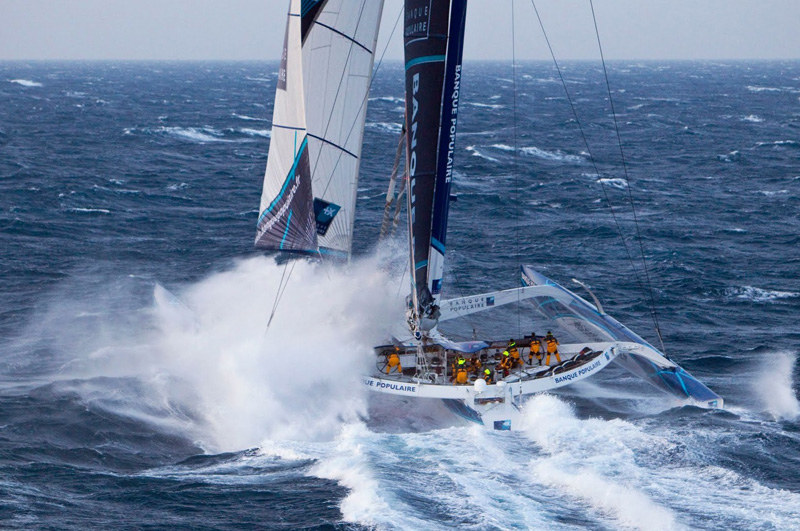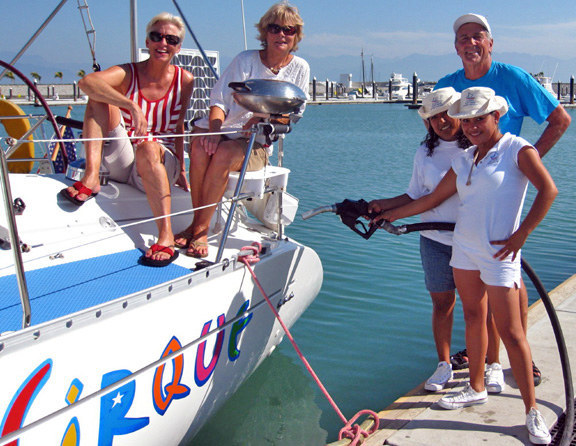
How Will You Celebrate Summer Sailstice?

As many grade-school scholars know, the summer solstice in the northern hemisphere occurs when our old friend Mr. Sun reaches his highest point in the sky, and consequently that’s the longest day of the year. Officially, the solstice occurs next Tuesday, June 21, but in much of the international sailing community, that date is being upstaged by this weekend, when Summer Sailstice celebrations will take place in prime sailing venues all over the northern hemisphere.
The brainchild of Latitude 38‘s John Arndt, the Sailstice’s basic idea is to give all types of sailors a good excuse to get out on the water and have some fun. And by registering online, participants are eligible to win a wide variety of prizes — including a weeklong bareboat vacation from Footloose Sailing Charters.
Over the years all sorts of special events have sprung up around the Sailstice theme. Check the website for links to many of them. Here in the Bay Area, the annual Sailstice shindig will take place at the Encinal YC tomorrow (June 18), with all sorts of fun and informative activities, including live music, exhibits and seminars — even a Latitude 38 seminar on the Baja Ha-Ha and Pacific Puddle Jump at 2 p.m.
Last year, sailors in all 50 states and 47 countries participated. That statistic prompted us to ask French sailing phenom Loïck Peyron for his throughts on the Sailstice concept: "This is a perfect year for me to participate in Summer Sailstice," says Loïck, "because it will be a full sailing weekend! On Saturday it’s the Bol d’Or in Suisse (on Lake Geneva), where I will sail on Okalys CORUM, a light-weight cat, with my Swiss mates. I hope it will a bit windier than the last two years, when we spent 24 hours on the lake fighting in no wind, because I need to be back in Brittany on Sunday for the start of the first race I will do on the maxi Trimaran Banque Populaire for the SNSM record — it starts from St. Nazaire at 6 p.m."
That effort would be hard to top, but you don’t have to be sailing on the largest tri in the world to enjoy a dose of Sailstice fun. So if you’re in town, check out the Encinal party. But most importantly, wherever you are, get out on the water and show your Sailstice spirit.
By the way, another salty affair you should be aware of this weekend is Vallejo’s annual Northern California Pirate Festival (on the waterfront), a wacky fun-for-the-whole-family event that includes nautical music, swordfighting, sailing, cannon-battles, theater, maritime crafts, food and drink, and all sorts of pirate gear for sale. Fear not, the pirates you’ll encounter there will be the ‘friendly, fun-loving’ sort of pirates, not the RPG-toting Somali variety.

However you spend the Sailstice weekend, have fun, be safe, and feel free to send us a few snapshots showing how you celebrated.
Coastal Cup Gets Breeze
For the 16 boats in the Encinal YC’s Coastal Cup, it hasn’t taken long to get down the coast. The first of Wednesday’s starters to reach the finish off the West End of Catalina Island, Steve Stroub’s Tiburon-based SC 37 Tiburon, finished at 6:11 this morning in 10-12 knots of breeze, only 45 hours after starting. But that 10-12 knots was a far cry from the 30-plus they saw throughout the race.
"These were the biggest waves I’ve ever surfed, apart from in the Molokai Channel," said Tiburon navigator Will Paxton. "I didn’t think she could do it, but she just rampaged. We were seeing sustained surfs of 20-plus knots and even put up a 23.5-knot top speed on the GPS. The bow wave was back at the primary winches!"
Paxton gave credit to a an old-style 77-sq-meter J/105 kite they brought along as a backup. After tearing their main four hours into the race, Tiburon sailed with a reef and that kite all the way to the finish.
"About a week before the race, I was thinking that the last time I did this race, I had to drop out because we blew up all of our kites," Stroub said. "So I called up the guy who bought my old J/105, and asked him if we could buy back the kite. It’s a 1.5-oz kite that I’d bought right before the rule changed (to allow larger spinnakers) and had only been used once. That sail rocked! It was about six feet short on the hoist and two feet short on the tack, and it was perfect."
The ‘sharks’ didn’t have an otherwise trouble-free race. Fifty miles out from the finish, the steering system exploded, and they spent 45 minutes on their side, hove-to — or in certain cases, dry-heaving — while Paxton rebuilt the steering system.
"It was the epic downhill, heavy air, gear-busting race it’s supposed to be," Paxton said.
Rufus Sjoberg and Dylan Benjamin aboard the former’s 11 Meter Skiffsailingfoundation.org were not far behind, and may stand a good chance at overall honors also, although we can’t be sure, as there are no official finish times posted yet. The Thursday starters are currently being led on elpased time by Richard Clark’s Open 60 Oh Canada, which like many of the boats found pressure well offshore — Tiburon got as far as 120 miles off the coast at one point. Keep checking on the race’s webpage for more info, and look in the July issue of Latitude 38 for more on this barnburner of a race.
Which is the ‘Failing State’?
Northern California’s Louis Kruk sailed to Mexico about four years ago with his sweetheart Laura Willerton aboard their Beneteau 42 Cirque. They only intended to cruise Mexico for about four months, but they enjoyed it so much they’ve been doing it every winter since.

©2011 Latitude 38 Media, LLC
For those of you who are thinking about cruising to Mexico, or are just interested in our neighbor to the south, Kruk forwarded a report on the country by Louis E.V. Nevaer that appeared in New America Media. It’s not sailing specific and it’s rather long, so if you’re not that interested in the general subject of Mexico, ignore it. But for those who care, it provides a very different view of Mexico than is normally presented in the United States media, one that Kruk thinks more Americans should hear about.
MERIDA, Mexico— At a time when the United States is confronting the possibility of a “double dip” recession, Mexico’s economy is expanding at the fastest pace in a decade.
For most of the 20th century, Mexicans lamented that when the U.S. economy slowed down, Mexico, ever so dependent on its neighbor to the north, suffered a recession. “When the U.S. gets a cold, Mexico gets pneumonia,” was a familiar saying among officials and executives on both sides of the border.
When the global recession hit in 2008, it seemed the same pattern would hold true again: In 2009, Mexico’s economy contracted 6.1 percent. Mexican officials feared that draconian immigration laws would result in the deportation of hundreds of thousands of Mexicans back to Mexico, where they would face certain unemployment. They also feared a collapse in demand for Mexican exports by recession-hit American consumers.
But the opposite has occurred. Mexico’s economy is enjoying a period of robust growth as a direct result of internal migrations away from the U.S.-Mexico border to mid-size Mexican cities, and the repatriation of investment capital from Mexicans living overseas, primarily in the U.S.
The Central Bank’s Key Role
As the global recession unfolded, Mexican President Felipe Calderon relied on Agustin Carstens, director of the central bank, to steer a financial policy for the nation. The result has been stunning.
Mexico’s gross domestic product (GDP) expanded 5.5 percent in 2010, and it is on track to grow 4.5 percent this year. Carstens is now being mentioned as a leading candidate to take over the International Monetary Fund after Dominique Strauss Kahn’s abrupt resignation. Other equally competent Mexican officials have worked to spur internal economic development. Finance Minister Ernesto Cordero, for instance, has made a point of focusing on internal growth rather than exports.
“It’s much more balanced growth with a much more dynamic domestic sector,” Cordero told reporters in Mexico City recently, emphasizing the Calderon administration’s emphasis on fueling domestic demand.
Middle-Class Resilience
The result has been an invigoration of Mexico’s middle class. Given the sluggishness of the U.S. economy, Mexican professionals — once lured to the U.S. by Fortune 500 companies — are seeking opportunities in mid-size Mexican cities. This, in turn, is fueling new economic activity and encouraging domestic demand.
In the decade since 9/11, when U.S. officials made it more difficult for Mexican citizens to secure tourist and work visas, Mexicans have opted for alternatives. A case in point is the rapid economic development taking place in Mexico’s Yucatan peninsula. Unable to send their kids to Orlando, Mexicans have sent them to Cancun. Unable to seek medical care in Miami, they have traveled to Merida. Prevented from purchasing vacation homes in Palm Springs, they have invested in Playa de Carmen.
Where Americans can’t find the money to fill in potholes, Mexico is accepting bids for a new, world-class airport along the 65-mile Cancun-Tulum corridor that is expected to serve 700,000 passengers its first year. While the U.S. had to abandon plans for fast trains that would have linked Tampa-Orlando and New York-Washington, Mexico plans a bullet train that will link Merida’s one million residents to Cancun.
American homes languish unsold for years, while half-million dollar homes are going up in fancy Mexican communities such as the Yucatan Country Club, which boasts a Jack Nicklaus golf course and a Mark Spitz swimming academy. This economic vitality is seen in many areas of the country, far removed from the drug-related violence that plagues the border region.
The strength of Mexico’s middle class can also be measured by the maturity of its democratic institutions. In 2000, for instance, Mexico was governed by an authoritarian regime, a single-party state that controlled or co-opted the nation’s socioeconomic and political organizations. In less than a decade it has become a true democracy, one in which the president is from a conservative party (PAN), most of the governors are from a centrist party (PRI) and the country’s largest city — Mexico City — is run by a mayor from a leftist party (PRD). Had anyone predicted in 2000 that this would be political reality in Mexico by 2010, it would have seemed like a fantasy.
Internal Population Shifts
The sluggish U.S. economy and stricter immigration controls are two of the key factors driving the boom. The number of illegal immigrants to the U.S. fell from roughly 850,000 a year in the years before the recession to 300,000 a year from 2007 to 2009, according to a report from the Pew Hispanic Center.
True, many of Mexico’s poorest people still risk their lives to find menial labor in the U.S., but the semi-skilled are finding more opportunities at home. The result has been an internal migration to where the jobs are. Mexico’s Census Bureau, known as INEGI, for instance, reported a 16 percent increase in Yucatan State’s population — almost all of it from people moving in from other parts of Mexico, and not from higher birth rates.
Mexican sociologist M. Bianet Castellanos chronicles the vast influx of Maya migration to the resorts along the Maya Riviera — people who, a generation ago, would have made their way to the agricultural fields of California and the bodegas of New York. They are finding better jobs in Mexico than they would in the U.S. — and without risking their lives at the hands of human traffickers, U.S. law enforcement agents, drug warlords, or American racists who subject Mexicans in the U.S. to hate crimes.
At the same time, Mexico’s economy is being energized and diversified by the arrival of working-age Americans. A generation ago, it was not uncommon to see entire communities of American expatriates—senior citizens living on Social Security, enjoying retirements of leisure, spending the afternoons playing golf, beach-combing and sipping margaritas. Now, younger Americans are also coming to Mexico to start families and open businesses. American officials estimate that there are more Americans living in Mexico than in any other country and who are fiercely loyal to Mexico.
Drug Violence in Perspective
This economic growth, unprecedented in its strength in more than a generation, is taking place at a time when the country is facing a wave of drug war violence.
But one reason the violence is so shocking is that it is out of the norm. “In a country of more than 100 million people, the odds of being killed in a drug-related homicide in 2010 were one in 6,667, about the same as the odds of being killed in an automobile accident in the United States (about one in 6,500). The odds of being killed in Mexico’s drug violence decrease dramatically if a person is not a drug trafficker, mayor, or police officer in a disputed trafficking region,” Viridiana Rios and David Shirk write in Drug-Related Killings in Mexico, 2008-2010, published by the Trans-Border Institute at the University of San Diego.
Fear-mongering by American writers is hardly new. “This is an attempt to understand Mexico’s steep descent into turmoil,” wrote one alarmed reviewer of Andres Oppenheimer’s 1998 book, Bordering on Chaos, which lamented that Mexico was becoming a “failed state.”
Thirty years before that, Barry Goldwater was among those calling Mexico, then hosting the Summer Olympic Games, a “failed state.” Decades from now, Americans will no doubt still be uttering the same clichés. Fast forward a dozen years after Oppenheimer’s failed book, and Mexico, despite its “out of control” image, is flourishing.
Now when the U.S. catches a cold, Mexico can say, “Bless you,” and go about its business.
